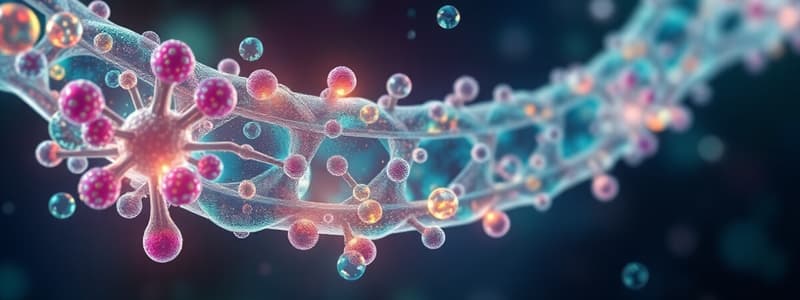Podcast
Questions and Answers
What does the height of the rocket in an assay indicate?
What does the height of the rocket in an assay indicate?
- Antibody purity
- Rate of chemical reaction
- Antigen concentration (correct)
- Electrophoresis speed
What is a starting point for conducting a Latex Agglutination Assay?
What is a starting point for conducting a Latex Agglutination Assay?
- Calculating optimal temperature
- Preparing the standard and samples (correct)
- Inoculating a culture
- Diluting the antisera
In crossed immunoelectrophoresis, what is the second dimension of separation?
In crossed immunoelectrophoresis, what is the second dimension of separation?
- Ultrafiltration
- Electrophoresis at right angles (correct)
- Western blotting
- Centrifugation
What can lead to the Hook effect in immunoassays?
What can lead to the Hook effect in immunoassays?
What is the role of antiserum in immunodiffusion assays?
What is the role of antiserum in immunodiffusion assays?
Which is a characteristic of the Latex Agglutination Assay?
Which is a characteristic of the Latex Agglutination Assay?
What does a precipitate indicate in crossed immunoelectrophoresis?
What does a precipitate indicate in crossed immunoelectrophoresis?
What is considered when defining the zones in immunodiffusion assays?
What is considered when defining the zones in immunodiffusion assays?
What indicates that both reactants are present in a label free assay?
What indicates that both reactants are present in a label free assay?
Which zone corresponds to the point where the concentration of Ag lies within the equality during immunodiffusion assays?
Which zone corresponds to the point where the concentration of Ag lies within the equality during immunodiffusion assays?
In the Ouchterlony immunodiffusion assay, how long is the dish typically incubated?
In the Ouchterlony immunodiffusion assay, how long is the dish typically incubated?
What is a key factor that affects the size of precipitin rings in single radial immunodiffusion (sRID)?
What is a key factor that affects the size of precipitin rings in single radial immunodiffusion (sRID)?
Which technique offers more rapid detection compared to single radial immunodiffusion?
Which technique offers more rapid detection compared to single radial immunodiffusion?
In the single radial immunodiffusion assay, how is the concentration of Ag in a sample related to the diameter of the precipitin ring?
In the single radial immunodiffusion assay, how is the concentration of Ag in a sample related to the diameter of the precipitin ring?
What role do negatively charged Ag play in the Rocket immunodiffusion?
What role do negatively charged Ag play in the Rocket immunodiffusion?
What is the primary function of visualizing Ab-Ag complexes in immunoassays?
What is the primary function of visualizing Ab-Ag complexes in immunoassays?
Flashcards
Hook Effect
Hook Effect
A phenomenon where high concentrations of an analyte (antigen or antibody) inhibit the formation of visible immune complexes, leading to a false-negative result.
Immunodiffusion Assay
Immunodiffusion Assay
An assay that measures the presence and amount of a specific antigen or antibody in a sample by observing the formation of visible precipitates.
Immunoelectrophoresis
Immunoelectrophoresis
An immunodiffusion assay where proteins are separated based on charge and then reacted with antibodies to visualize specific proteins in the sample.
Rocket Immunoelectrophoresis
Rocket Immunoelectrophoresis
Signup and view all the flashcards
Crossed Immunoelectrophoresis
Crossed Immunoelectrophoresis
Signup and view all the flashcards
Latex Agglutination Assay (LAA)
Latex Agglutination Assay (LAA)
Signup and view all the flashcards
Equivalence Zone
Equivalence Zone
Signup and view all the flashcards
Label-Free Assays
Label-Free Assays
Signup and view all the flashcards
Ouchterlony Immunodiffusion
Ouchterlony Immunodiffusion
Signup and view all the flashcards
Single Radial Immunodiffusion (sRID)
Single Radial Immunodiffusion (sRID)
Signup and view all the flashcards
Rocket Immunodiffusion (Laurell Technique)
Rocket Immunodiffusion (Laurell Technique)
Signup and view all the flashcards
Prozone
Prozone
Signup and view all the flashcards
Postzone
Postzone
Signup and view all the flashcards
Study Notes
Introduction to Immunoassays
- Immunoassays are used to detect and measure antigens or antibodies.
- Label-free assays detect antibody-antigen complexes by their ability to scatter light.
- Visible complexes form due to Ab-Ag interaction.
- A constant concentration of Ab can be used to measure specific Ag.
- Alternatively, coated cells or particles bind to the target Ab or Ag, causing precipitation or agglutination.
Learning Objectives
- Visualizing antibody-antigen (Ab-Ag) complexes
- Understanding label-free assays
- Defining pre-zone, equivalence-zone, and post-zone
- Understanding the principles of immunodiffusion assays
- Providing examples of immunodiffusion assays
- Describing the Latex agglutination assay (LAA) procedure
Label-Free Assays - Equivalence
- Pro zone: Antibody excess, little precipitation.
- Zone of equivalence: Optimal amount of Ag and Ab, maximum precipitation.
- Post zone: Antigen excess, little precipitation.
Immunodiffusion Assays
-
Ouchterlony Immunodiffusion Assay (Double Diffusion):
- Antibody (Ab) placed in center well, antigens in surrounding wells.
- Ab-Ag complexes form precipitin lines
- Patterns indicate similarities or differences between Ag.
- Patterns include identity, partial identity, and non-identity.
-
Single Radial Immunodiffusion (sRID) or Mancini Technique:
- The precipitin ring size depends on antigen concentration, antibody concentration, and sample volume.
- Rings form when Ag concentration is within the zone of equivalence.
- Precipitate diameter is proportional to antigen concentration (linear plot).
Activity - sRID Data
- Example data tables for X-179A and X-187
- Results for sRID assays including untreated, acid, etc
Immunodiffusion Assays - Electroimmunodiffusion
- Rocket Immunodiffusion (Laurell Technique):
- Electrophorosis of the antigen(Ag) in an agarose gel containing antibody(Ab).
- The negatively charged antigen migrates towards a positive charge.
- Rocket height is proportional to the antigen concentration.
Immunodiffusion Assays - Immunoelectrophoresis
- Investigation of proteins in a complex mixture to identify immunological characteristics.
- Separating the protein samples by electrophoresis in circular wells.
- Antiserum is placed in a central slot, antibodies precipitate proteins during diffusion.
Crossed Immunoelectrophoresis
- First dimension: Separating proteins by electrophoresis.
- Second dimension: Separated proteins further electrophoresed into a gel containing antibodies against the protein.
- Precipitates form, peak or rocket shapes, area proportional to amount of Ag.
Latex Agglutination Assay (LAA)
- Quick alternative to traditional immunodiffusion.
- Samples (blood, saliva, cerebrospinal fluid (CSF))
- Latex beads coated with antigen for antibody capture.
- Steps include: preparation of standard and samples, serial dilutions, preparation of beads, sample loading, and spectrophotometer reading.
- Total duration is two hours
The Hook Effect
- High analyte concentrations inhibit complex formation, restricting sensitivity.
- Leading to lower detection limits.
Studying That Suits You
Use AI to generate personalized quizzes and flashcards to suit your learning preferences.



